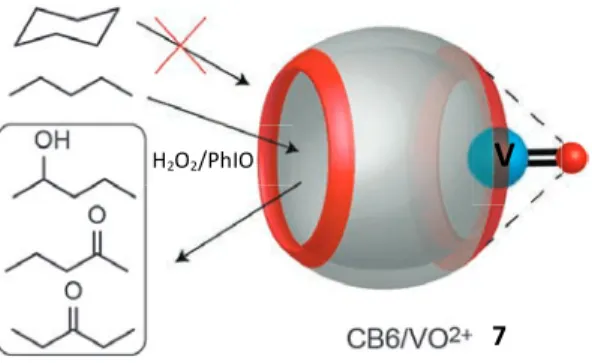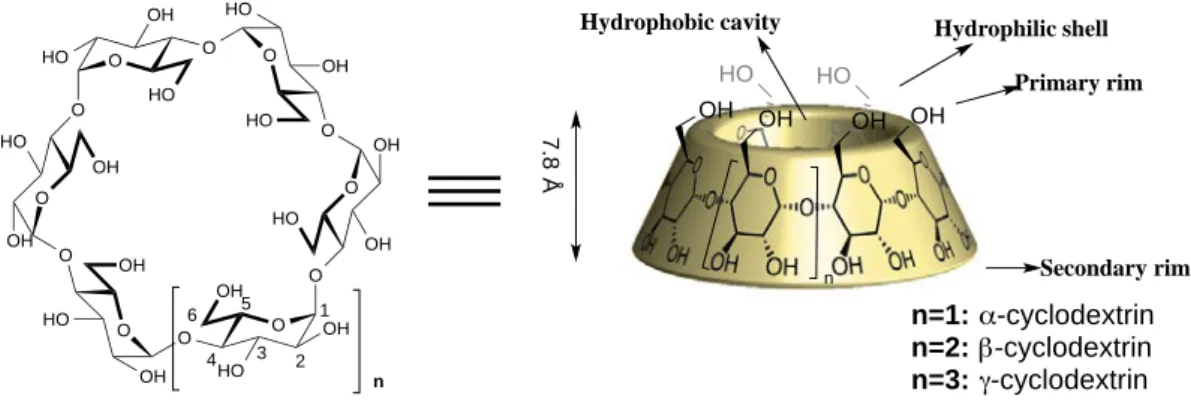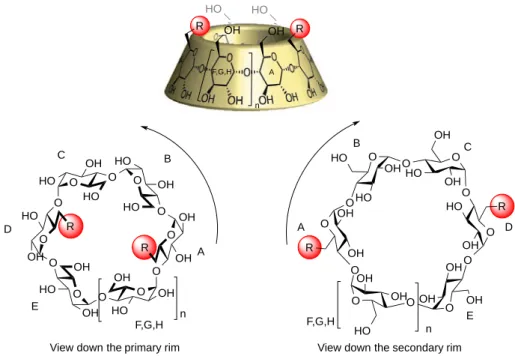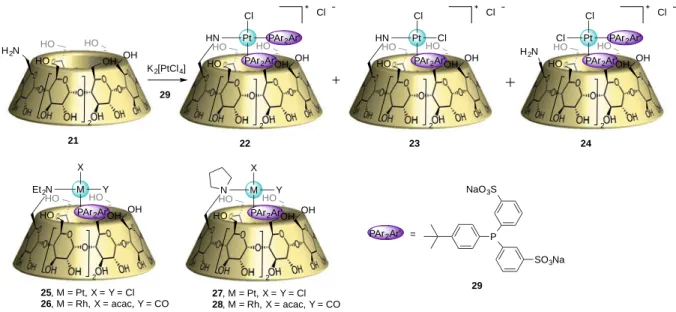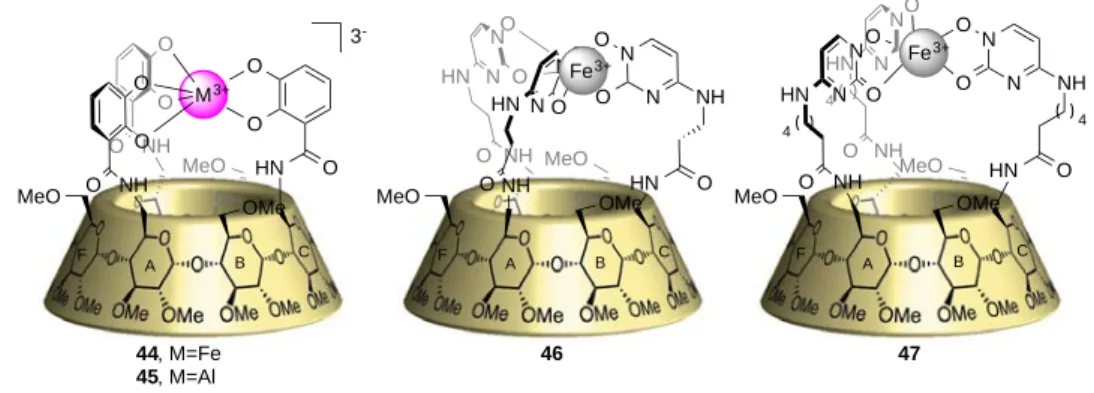HAL Id: tel-01310154
https://tel.archives-ouvertes.fr/tel-01310154
Submitted on 2 May 2016
HAL is a multi-disciplinary open access archive for the deposit and dissemination of sci-entific research documents, whether they are pub-lished or not. The documents may come from teaching and research institutions in France or abroad, or from public or private research centers.
L’archive ouverte pluridisciplinaire HAL, est destinée au dépôt et à la diffusion de documents scientifiques de niveau recherche, publiés ou non, émanant des établissements d’enseignement et de recherche français ou étrangers, des laboratoires publics ou privés.
Complexes for Cavity-Dependent Catalysis
Pinglu Zhang
To cite this version:
Pinglu Zhang. Cyclodextrin-(N-Heterocyclic Carbene)-Metal Complexes for Cavity-Dependent
Catal-ysis. Organic chemistry. Université Pierre et Marie Curie - Paris VI, 2015. English. �NNT :
THÈSE DE DOCTORAT DE
L’UNIVERSITÉ PIERRE ET MARIE CURIE
ÉCOLE DOCTORALE : CHIMIE MOLÉCULAIRE – ED 406 Spécialité: Chimie Organique
Présentée Par
Mlle Pinglu ZHANG
POUR OBTENIR LE GRADE DE
DOCTEUR Sujet de la thèse:
Cyclodextrin-(N-Heterocyclic Carbene)-Metal Complexes for
Cavity-Dependent Catalysis
Directeur de recherche: Pr. Matthieu SOLLOGOUB
Soutenance prévue le 30 Octobre 2015:
Devant le jury composé de:
Monsieur le Professeur Éric MONFLIER Rapporteur Monsieur le Professeur Alexandre MARTINEZ Rapporteur Monsieur le Professeur Olivier RIANT Examinateur Monsieur le Professeur Alexandre ALEXAKIS Examinateur Madame le Docteur Corinne AUBERT Président Monsieur le Docteur Mickaël MÉNAND Invité
Monsieur le Docteur Yongmin ZHANG Directeur de thèse Monsieur le Docteur Sylvain ROLAND Directeur de thèse
Abstract in English
Cyclodextrin (CD)-NHC-Metal complexes (NHC=N-Heterocyclic Carbene), including the AgI, CuI and AuI complexes were synthesized. A structural study showed that the metal was inside the cavity, and induced by C-H…M, C-H…X and π…X interactions. Variations on α-, β-, γ-CD cavities and NHC derivatives (midazole, benzimidazole, triazole) were studied. When the size of the cavity increased, these interactions decreased. Furthermore, stronger σ-donating effects lead to stronger interactions. CD-Cu complexes showed good activity in catalytic hydroboration of alkynes. The selectivity is depending on the size of the cavity of the catalyst. α-CD copper complex gives linear hydroboration products, while β-CD copper complex yields the branched isomers. The CD-Cu species potentially involved in the catalytic cycle were studied, two different mechanisms were thus proposed. In the α-CD-Cu complex catalyzed reactions, the catalytic process takes place outside the cavity; while a bigger cavity β-CD permits the catalysis to take place inside the cavity. Furthermore, the gold complexes also show different enantioselectivity and regioselectivity in cycloisomerization using different cavity-based catalysts. Catalytic results evidenced the selectivity of a catalytic reaction is dependent on the cavity of the CD-NHC-metal complexes.
Keywords: Cyclodextrins, N-Heterocyclic Carbenes, Mesoionic Carbenes, Organometallics, Catalysis
Résumé en Français
Des complexes de Cyclodextrine (CD)-NHC-Métaux (NHC= Carbènes N-Hétérocycliques), comprenant des métaux tel que AgI, CuI et AuI ont été synthétisés. Une étude structurale a mis en évidence la position intra-cavitaire du métal, induisant des interactions C-H…M, C-H…X et π…
X. L’influence du type de cavité (α-, β-, γ-CD) et du type de dérivés NHC (Imidazole, benzimidazole, triazole) a été étudiée. Les interactions diminuent avec l’augmentation de la taille de la cavité et en parallèle, celles-ci ont été amplifiées avec des dérivés NHC possédant un effet donneur plus fort. Les complexes de cuivre correspondants montrent une bonne réactivité pour la réaction d’hydroboration des alcynes. Il a de plus été observé que la sélectivité est dépendante de la taille de la cavité. En effet, alors que le complexe α-CD-Cu donne le produit linéaire, le complexe β-CD-Cu oriente vers la formation de l’isomère branché. Les espèces CD-Cu potentiellement impliquées dans le cycle catalytique ont été étudiées. Deux mécanismes différents sont ainsi proposés. Dans la réaction catalysée par le complexe α-CD-Cu, le processus catalytique a lieu en dehors de la cavité; tandis que lorsque la cavité est plus grande (β-CD) la catalyse a lieu à l’intérieur de la celle-ci. Par ailleurs, les complexes ont également montré une différente énantiosélectivité et régiosélectivité dans une réaction de cycloisomerization catalysée par des comlexes dor, en fonction de la taille de la cavité de ces catalyseurs. Les résultats catalytiques ont prouvé que les complexes CD-NHC-Métaux fonctionnent comme des catalyseurs pour lesquels la taille de la cavité influe sur la séléctivité.
Mot-clés: Cyclodextrines, Carbènes N-Hétérocycliques, Carbènes Mésoionique,
i
Acknowledgements
First of all, I would like to thank all the jury members who are willing to be present in my defense and spend time reading my manuscript.
This work is achieved in group of Glycochimie Organique Biologique et Supramoléculaire (GOBS). This thesis would not be possible realized without the support of many people who have helped me during these years.
Firstly, I would like to thank Dr. Yongmin Zhang for offering me the oppotunity to study in France and giving meticulous care in my daily life.
I am heartily thankful to my supervisor Pr. Matthieu Sollogoub, who accepter me in this wonderful group and have the extraordinary experience in cyclodextrin chemistry. He is a real scientist, teaches me not only chemistry knowledge but also scientific attitude. When I was trapped in a dilemma in chemistry, he gave me continuous support with invaluable advices. And he is also a guider of my career, who gave me very important suggestions.
I would like to express my deep gratitude to Dr. Mickaël Ménand, who taught me knowledge of cyclodextrins from the very first beginning, and taught me how to analyze detail information from complicated NMR spectrum. And more important, he taught me an attitude: do not miss any details, they are the key to an elegant work. Every moment I needed his support, he had never hesitated, I feel so touched for his kindness and patience.
I am grateful to Dr. Sylvain Roland for his great help on this subject. Everytime I want to find some non-‐common used chemical reagents, he can perform the magic! And thanks for taking good care of me when we were in Lisbon. At the same time I really appreciate him for helping me correct my manuscript.
I would like to show my gratitude to Prof. Louis Fensterbank, Dr. Virginie Mansuy, Prof. Bernold Hasenknopf, Dr. Guilaume Vives, Prof. Olivier Riant, Prof. Serge Thorimbert, Dr. Olivia Bistri for their valuable advices and helps during my study. I would like to express my appreciation to Sylvie Paller-‐Jammes, Omar Khaled, Elsa caytan, Bruno Ricci and Aurélie Bernard for their assistance and kindness.
ii
I would like to give great thanks to Dr. Bo Wang, Dr. Shaoping Wu, Dr. Dan Lu and Sha Zhu, for sharing happiness, or even sadness. During these years, we are not able to spend the traditional Chinese New Year with our own family. But in France, they treated me like family. They support me not only on my project in the lab, but also on my daily life.
Thanks Dr. Wenjing Xuan, Xiaolei Zhu, Hongxi Lei for sharing and supporting in many ways, I am so happy to meet you in this romantic city.
Thanks Dmitri Colesnic and Dr. Diem Ngan Tran for helping me so much in the lab, I am really glad to work togother with them. Many thanks go to Julien Rossignol, Dr. Renaud Barbeyron, thanks for having “concerts” in the lab, the fantastic atmosphere will catalyze the chemical reactions!
Heartfelt thanks to Pierre Evenou, Jérémy Scelle, Coralie Tugny, Sébastien Leloux for their warm support. I would like to thank Dr. Ségolène Adam de Beaumais, she is so nice to me when I was a freshman in the lab. Thanks Dr. Maxime Guitet for giving me precious advices on this subject.
I would like to thank Jorge Meijide Suarez, Julien Guillemin for their supporting; thanks Mariecka Rose, Guillaume Le Heiget for their kindness.
Thanks Xudong He, Muzhi Xu, Lichao Pan, Jhongwei Syu for their accompany in Paris. They encourage me to go through the days I feel frustrated and anxious. These friendships give me so warm support.
I sincerely acknowledge China Scholarship Council for a PhD fellowship.
Last, I would like to thank my family, for their continuous supporting during these years.
iii
Table of Contents
ACKNOWLEDGEMENTS ... i
ABBREVIATIONS ... vii
CHAPTER I. INTRODUCTION
1 Organometallic catalysis ... 12 Catalysis in confined spaces ... 1
3 Organometallic catalysis with the help of the cavity of concave cycles ... 3
3.1 Calixarenes ... 4
3.2 Cucurbiturils ... 6
4 Organometallic catalysis with the help of cyclodextrin cavity ... 9
4.1 General introduction of cyclodextrins ... 9
4.1.1 Definition and properties ... 9
4.1.2 Nomenclature ... 11
4.2 General patterns using the cavity of CD-‐metal complexes ... 12
4.3 The structures of cyclodextrin-‐metal complexes ... 14
4.3.1 Monosubstituted cyclodextrin-‐metal complexes ... 14
4.3.2 Polysubstituted cyclodextrin-‐metal complexes ... 19
4.3.2.1 Functional groups on CD as dentate ligands ... 19
4.3.2.2 Capped bridge on CD as dentate ligands ... 27
4.4 Use of the cavity of CD-‐metal complexes in organometallic catalysis ... 28
4.4.1 One cavity with one metal ion ... 28
4.4.1.1 Hydrolysis reaction ... 28
4.4.1.2 Hydroformylation reaction ... 31
4.4.1.3 Reduction reaction ... 33
4.4.1.4 Polymerization reaction ... 34
4.4.2 Two cavities with one metal ion ... 34
4.4.2.1 Hydrolysis reaction ... 35
4.4.2.2 Oxidation reaction ... 38
4.4.3 Two cavities with several metal ions ... 39
4.4.4 Several cavities with one metal ion ... 40
5 NHC-‐Functionalized cyclodextrin-‐metal complexes ... 41
5.1 N-‐heterocyclic carbenes (NHCs) ... 41
5.2 NHC-‐metal complexes ... 43
iv
CHAPTER II. STUDY OF NHC- AND MIC- BRIDGED CD-METAL
COMPLEXES
1 Retrosynthesis of NHC-‐bridged CD-‐metal complex ... 49
2 Synthesis of α-‐, β-‐ and γ-‐CD diols with DIBAL-‐H ... 49
2.1 Diisobutylaluminum Hydride (DIBAL-‐H) mediated debenzylation ... 50
2.2 Rationalization of the selectivity for α-‐ and β-‐CDs debenzylation ... 51
2.3 Previous work on selective debenzylation of γ-‐CD ... 52
2.4 Screening of reaction conditions for the γ-‐CD debenzylation ... 54
2.5 Rationalization of γ-‐CD triol isomers ... 55
3 Study of NHC-‐bridged CD-‐metal complexes ... 56
3.1 Imidazole-‐bridged CD-‐metal complexes ... 56
3.1.1 Previous characterization of Im-‐α-‐CD-‐metal complexes ... 58
3.1.2 Study of Im-‐β-‐CD-‐metal complexes ... 60
3.1.3 Study of Im-‐γ–CD-‐metal complexes ... 65
3.1.3.1 6A,6E imidazole-‐bridged γ–CD-‐metal complex ... 65
3.1.3.2 6A,6D imidazole-‐bridged γ–CD-‐metal complex ... 68
3.2 Synthesis of Di-‐tert-‐butyl-‐imidazolium-‐bridged α-‐CD derivative ... 71
3.3 Study of benzimidazole-‐bridged CD-‐metal complexes ... 72
3.3.1 Benzimidazole-‐bridged α-‐CD-‐metal complexes ... 73
3.3.2 Benzimidazole-‐bridged β-‐CD-‐metal complexes ... 74
3.4 Synthesis of other NHC-‐bridged α-‐CD derivatives ... 78
4 Study of MIC-‐bridged CD-‐Metal complexes ... 78
4.1 Study of methylated-‐triazolium-‐bridged α-‐CD-‐metal complexes ... 78
4.2 Synthesis of other MIC-‐bridged α-‐CD derivatives ... 85
4.3 Study of methylated-‐triazolium-‐bridged β-‐CD-‐metal complexes ... 87
5 Study of counter-‐ion exchange in the metal-‐complexes ... 90
5.1 Removal of halogen in Im-‐bridged α-‐, β-‐CD-‐MCl ... 90
5.1.1 Im-‐α-‐, β-‐CD-‐AgCl ... 90
5.1.2 Im-‐α-‐, β-‐CD-‐AuCl ... 91
5.2 Removal of halogen in Bim-‐bridged α-‐, β-‐CD-‐AuCl ... 93
5.3 Removal of halogen in MIC-‐bridged α-‐CD-‐AuI ... 94
CHAPTER III. CATALYTIC APPLICATIONS OF NHC-CD-METAL
COMPLEXES
1 Hydroboration catalyzed by NHC-‐Cu complexes ... 97v
1.1 Hydroboration of alkynes catalyzed by NHC-‐Cu complexes ... 100
1.1.1 Hydroboration of terminal alkynes ... 100
1.1.2 Hydroboration of internal alkynes ... 103
1.2 Hydroboration catalyzed by NHC-‐bridged Cyclodextrin-‐Cu complexes ... 106
1.2.1 Hydroboration of terminal alkynes catalyzed by NHC-‐bridged α-‐CD-‐Cu complexes ... 106
1.2.1.1 Im-‐α-‐CD-‐CuCl as catalyst ... 106
1.2.1.2 Im-‐α-‐CD-‐CuOH as catalyst ... 109
1.2.1.3 Deuterium labeling experiments ... 112
1.2.1.4 Examplification with different substrates ... 114
1.2.1.5 Proposed mechanism ... 115
1.2.2 Hydroboration of internal alkynes catalyzed by NHC-‐bridged α-‐CD-‐Cu complexes ... 116
1.2.3 Hydroboration of terminal alkynes catalyzed by NHC-‐bridged β-‐CD-‐Cu complexes ... 117
1.2.3.1 Im-‐β-‐CD-‐CuCl as catalyst ... 117
1.2.3.2 Im-‐β-‐CD-‐CuOH as catalyst ... 119
1.2.3.3 Deuterium labeling experiments ... 123
1.2.3.4 Optimization reaction conditions and examplification for different substrates ... 125
1.2.3.5 Proposed mechanism ... 129
1.2.4 Hydroboration of internal alkynes catalyzed by NHC-‐bridged β-‐CD-‐Cu complexes ... 131
2 Cycloisomerization catalyzed by NHC-‐CD-‐Au complexes ... 132
GENERAL CONCLUSION AND PERSPECTIVES ... 137
EXPERIMENTAL PART ... 143
vi
vii
Abbreviations
Ac Acetyl Bn Benzyl Bu Butyl Cat. Catalyst CD CyclodextrinCOSY COrrelated SpectroscopY
Cy Cyclohexane
DCM DiChloroMethane
DEPT Distortionless Enhancement by Polarization Transfer DIBAL-‐H Di-‐isolutylaluminium Hydride
DIPEA N,N-‐diisopropylethyl-‐amine
DMAP 4-‐Dimethylaminopyridine
DMF N,N-‐Dimethylformamide
DMSO Dimethylsulfoxide
ee Enantiomeric excess
eq. Equivalents
ESI Electro-‐Spray Ionisation
GC Gas Chromatography
h Hour
HMBC Heteronuclear Multiple Bond Correlation HRMS High Resolution Mas Spectrometry
HSQC Heteronuclear Single-‐Quantum Coherence
Hz Hertz
J Coupling constant
m Meta
m/z Isotopic mass-‐to charge ratio
Me Methyl
MIC Mesoionic Carbene
Min Minutes
Ms Methanesulfonyl (Mesyl)
MS Mass spectrometry
n.d Not determined
n.i Not isolated
viii
NOESY Nuclear Overhauser Effect SpectroscopY NMR Nuclear Magnetic Resonance
Nu Nucleophile
o Ortho
p Para
Ph Phenyl
Ppm Parts per million
Py Pyridine Quant. Quantitative Rf Retention factor r.t. Room Temperature s second TBA Tetrabutylammonium TBS or TBDMS tert-‐Butyldimethylsilyl Tf Triflate (trifluoromethanesulfonate) THF Tetrahydrofuran TLC Thin-‐Layer Chromatography TMS Trimethylsilyl TOCSY Ts
TOtal Correlation SpectroscopY Toluene-‐4-‐sulfonyl
Chapter I
Introduction
1
1 Organometallic catalysis
The concept of catalysis was first invented by the chemist Elizabeth Fulhame and described in 1794, based on her novel work in oxidation-‐reduction experiments.1 Nowadays, catalysis has grown to play a prominent role in science as it enables the preparation of chemicals in an efficient manner.2 Estimates are that 90% of commercially produced chemical products involve catalysts in the process of their manufacture.
The excellent chemical properties of organometallic are keystone in chemical sciences. Nobel prizes for organometallic chemistry have been awarded to Zieger and Natta (1963), Fischer and Willkinson (1973), Chauvin, Schrock and Grubbs (2005), Heck, Negishi and Suzuki (2010) for their outstanding contributions. Organometallic catalysts have provided a series of important conceptual insights, surprising applications both for industrial processes and organic synthesis, which are attractive for a large amount of people working in this field.
2 Catalysis in confined spaces
Despite substantial progress in the organometallic catalysis field, there are still many reactions for which the selectivity and activity cannot be well controlled. However, enzymes, as nature’s catalysts, do a great job for both selectivity and reactivity. Generally, metalloenzymes have a bigger size than traditional organometallic catalysts. The large protein surrounding the active site often provides a well-‐defined confined space around the active center. Therefore, in a molecular container, encapsulating a metal or a substrate in a confined space can impose steric restrictions, and mimic the second coordination sphere effects of a protein matrix around the active site of a metalloenzyme.
Recently, organometallic catalysis in confined spaces has shown to be a viable method to induce new selectivities and activities.3,4 This strategy can even lead to unusual selectivities and activities because the reaction pathway will differ from that of the normal reaction due to specific orientations in confined spaces.
These years, innovative catalytic systems have been developed based on well-‐confined spaces, involving a vast majority of metal complexes with self-‐assembled cage-‐like structures and classical complex units LM, which have been summarized in recent reviews.5,6,7,8 The
1 A. Cornish-‐Bowden, Elizabeth Fulhame and the discovery of catalysis, Universitat de València, Spain, 1997,
123-‐126.
2 R. A. Sheldon, I. Arends, U. Hanefeld, Green Chemistry and Catalysis, Wiley-‐VCH, Weinheim, Germany, 2007.
3 S. H. a. M. Leenders, R. Gramage-‐Doria, B. de Bruin, J. N. H. Reek, Chem. Soc. Rev. 2015, 44, 433–448.
4 M. Raynal, P. Ballester, A. Vidal-‐Ferran, P. W. N. M. Van Leeuwen, Chem. Soc. Rev. 2014, 43, 1734–1787.
2
second type is concave cycles, including calixarenes, cucurbiturils and cyclodextrins, which own a cavity as the confined space.
For the self-‐assembled cage-‐like structures and units LM, people start to transfer the focus point from merely design and synthesis, to take advantage of them in catalytic applications. Reek’s group reported many elegant works in metal-‐directed self-‐assembled cage field. Very recently, they used two opposing Zn-‐porphyrin building blocks, linked by four bridging macrocyclic walls that assemble the cage structure 1 through Pd-‐carboxylate coordination bonds (Scheme I-‐1).9 This cage is able to accommodate 1 molecule of [Rh(acac)(CO)
2] to form
a Rh encapsulated complex, which exhibits the highest chemo-‐ and stereoselectivity reported so far in the asymmetric hydroformylation of styrene for a monoligated Rh complex.
Scheme I-‐1. Asymmetric hydroformylation of styrene using assembled cage-‐Rh complex as catalyst The groups of Raymond and Bergman explored the application of an M4L6 anionic
tetrahedral capsule 2, which is formed by six bis-‐catecholamide struts and four octahedral gallium(III) centers. This capsule can be used to bind Ru, Ir, and Au cationic.10 The encapsulated Au-‐complex provided a different product distribution compared to the free complex Me3PAuCl. The authors used the Au-‐complex as catalyst in the cycloisomerization
6 J. Liu, L. Chen, H. Cui, J. Zhang, L. Zhang, C. Su, Chem. Soc. Rev. 2014, 6011–6061.
7 H. Vardhan, F. Verpoort, Adv. Synth. Catal. 2015, 357, 1351-‐1368.
8R. Chakrabarty, P. S. Mukherjee, P. J. Stang, Chem. Rev. 2011, 111, 6810–6918.
9 C. García-‐Simón, R. Gramage-‐Doria, S. Raoufmoghaddam, T. Parella, M. Costas, X. Ribas, J. N. H. Reek, J. Am.
Chem. Soc. 2015, 137, 2680-‐2687.
10 M. D. Pluth, R. G. Bergman, K. N. Raymond, Acc. Chem. Res., 2009, 42, 1650-‐1659.
N N N N N Pd Pd N Pd Pd Zn N N N N Zn O O O O O O O O
5, 10, 15, 20-tetrakis (4-carboxyphenyl)-porphyrin Zn (II) Pd Pd Zn Pd Pd Pd Pd Pd Pd Zn O O P NMe2 Rh O O OC N N O O + H2/CO 99 : 1 * 74% ee Cat. 1 0.02% 1 Toluene/MeCN = 4 :1 TON: 797
! \!
()'1+.#*!#B!)*%*)!1-- ].+=#5+!+=.,!1#*B.*)8!,&'1)I!+=)!B())!1#$&2)9!>)\@0562!.*851),!+=)!
B#($'+.#*!#B!+=)!=%8(#'2V#9%2'+)8!&(#851+!'-!F#S)/)(I!S=)*!+=)!()'1+.#*!+'V),!&2'1)!.*!+=)! 1#*B.*)8! 1'L)I! +=)! $)+'2E)*1'&,52'+)8! 1#$&2)9! #(.)*+,! +=)! 8.)*)! &! ',! +=)! $'`#(! &(#851+! O;1=)$)! CEWP-RR!"=.,! 12)'(2%! 8)$#*,+('+),! '*! .*8)&)*8)*+! ,)2)1+./.+%! ',,#1.'+)8! S.+=! +=)! )*1'&,52'+)8!05E1#$&2)9-!!!
()*+,+-./$0!6'+'2%+.1!A)='/.#(!#B!)*1'&,52'+)8!05E1#$&2)9!1#$&'()8!+#!*#*E)*1'&,52'+)8!05E1'+'2%,+! F)()I! S)! A(.)B2%! 8),1(.A)8! #*)! )9'$&2)! #B! '! 1'L)E2.V)! ,+(51+5()! '*8! D>! 1#$&2)9I! (),&)1+./)2%-!C*!B'1+I!.+!.,!'2,#!/)(%!.*+)(),+.*L!+='+!+=)!1'+'2%+.1!()'1+.#*,!+'V)!&2'1)!S.+=!+=)! =)2&!#B!1#*B.*)8!,&'1)!.*!1#*1'/)!1%12),-!"=)%!'()!1#$$)(1.'22%!'/'.2'A2)!S.+=#5+!B5(+=)(! 8),.L*I!'*8!+=)!,.4)!#B!+=)!1#*1'/)!.,!+5*'A2)!'11#(8.*L!+#!+=)!*5$A)(!#B!$#*#$)(!5*.+,-! "=5,I!.*!+=.,!.*+(#851+.#*!&'(+I!S)!S#528!2.V)!+#!8),1(.A)!,&)1.B.1'22%!+=)!1',),!#B!1'+'2%,.,! S.+=!1#*1'/)!1%12)E$)+'2!1#$&2)9),-!
3 Organometallic
catalysis with the help of the cavity
of
concave cycles
"=)!1#$A.*'+.#*!#B!1#*1'/)!1%12),!S.+=!#(L'*#$)+'22.1,!.,!'!/)(%!.$&#(+'*+!(),)'(1=!B.)28-! K)*)('22%I! +=)! B()J5)*+2%! '&&2.)8! $'1(#1%12),! .*1258)! 1%12#8)9+(.*,I! 1'2.9'()*),! '*8! 1515(A.+5(.2,I! &#,,),,.*L! 5*.J5)! +(.8.$)*,.#*'2! '(1=.+)1+5(),! S.+=! /'(.'A2)E,.4)8! 1'/.+.),I! '22#S.*L!+=)$!+#!A)!5,)8!',!'!()1)&+#(!OH.L5()!CERP-!
!!!!!!!!!!!!!!!!!!!!!!!!!!!!!!!!!!!!!!!!!!!!!!!!!!!!!!!!
RR!]-! F-! F'(+E1##&)(I! g-! Q-! 62'(%I! H-! 7-! "#,+)I! M-! K-! 3)(L$'*I! g-! Q-! M'%$#*8I! #>$ E%>$ =2+%>$ ?(8>! $%!$I! CBAI!
RTaT\ERTaT[-! O Me3PAuCl Me3P Au O O OH O OH + 5: 60% 4: 40% 4: 85% 3 H2O, 5% DMSO H2O, 5% DMSO X = Cl, Br Me3P Au X O O HN NH O O O O Ga Ga Ga Ga 2
4
Figure I-‐1. Chemical structures of concave cycles
3.1 Calixarenes
Calixarenes are a class of cyclic oligomers, synthesized via hydroxyl alkylation or condensation between phenols and aldehydes.12 Calix[n]arenes are made of n phenol and methylene units. Representative members of calixarenes are calix[4]arenes and calix[6]arenes, composed of 4 or 6 units, respectively. Calix[n]arenes are flexible structures (four conformations for calix[4]arene, eight conformations for calix[6]arene) in a three-‐ dimensional bowl shape with a defined upper and lower rim and a central annulus (Figure I-‐ 2). Such a bowl shape results in the formation of a hydrophobic electron-‐rich cavity, which is suited for the formation of inclusion complexes. Inspired by their unique geometries, calixarenes are attractive for applications in a variety of fields, such as artificial enzymes,13 ion sensitive electrodes or sensors14 and supramolecular chemistry.
Figure I-‐2. Structure of Calixarenes
The calixarenes are able to bind metals in various positions as illustrated in Figure I-‐3. The metal can be mono-‐bound or poly-‐bound to the upper rim or lower rim. The situation where the metal is encapsulated inside the cone was not reported so far.
12 C. D. Gutsche, Calixarenes, Royal. Soc. Chem., Cambridge, 1989, ISBN 0-‐85186-‐385-‐X.
13 D. T. Schühle, J. a. Peters, J. Schatz, Coord. Chem. Rev. 2011, 255, 2727–2745.
14 A. Mattiuzzi, I. Jabin, C. Mangeney, C. Roux, O. Reinaud, L. Santos, J. F. Bergamini, F. Hapiot, C. Lagrost, Nat.
Commun, 2012, 3, 1130. O O HO OH HO O O HO OH HO O O HO OH OH O O OH HO OH O O OH HO OH O O OH HO HO R R R R OH OH HO OH n N N O N N O N N O N N O N N O N N O N N O N N O N N O N N O n n
Cyclodextrins Calixarenes Cucurbiturils
!
OH OH HO R R R R OH Calixarenes upper rim annulus lower rim n n=1,2,3...5
Figure I-‐3. Potential metal binding positions in a calixarene ligand system (R=assorted functionality) Due to a high flexibility of the calixarene structure, mono-‐bound or even bis-‐bound motif with metal (1,2 alternate, 1,3 alternate) still leaves the possibility of alternative conformations. It is hard to constrain it in a cone conformation. In such flexible conformation, it is more difficult to control the metal position, and thus to use the cavity as a confined space for reactions catalyzed by calixarene-‐metal complexes.
Since a single linkage does not allow directional control, a possible strategy consists of grafting a tripodal cap on the rim. Reinaud and co-‐workers designed the calix[6]arene with several nitrogen-‐based donors at the edge of the cavity. It works as a polydentate ligand that can fold on the entrance of the cavity and coordinate to a metal ion,15 namely calix[6]tren,16 calix[6]tmpa,17 calix[6]PN
318and calix[6]N319(Figure I-‐4). This tripodal cap rigidifies the
calixarene onto a cavity-‐shape conformation and the metal is forced to point towards the hollow center, leading to a potential catalyst to carry out a reaction in the cavity.
Figure I-‐4. Calix[6]arene-‐based metal complexes
15 N. Le Poul, Y. Le Mest, I. Jabin, O. Reinaud, Acc. Chem. Res. 2015, DOI: 10.1021/acs.accounts.5b00152.
16 U. Darbost, M. N. Rager, S. Petit, I. Jabin, O. Reinaud, J. Am. Chem. Soc. 2005, 127, 8517–8525.
17 S. Blanchard, L. Le Clainche, M. Rager, B. Chansou, J. P. Tuchagues, A. F. Duprat, Y. Le Mest, O. Reinaud,
Angew. Chem. Int. Ed. 1998, 37, 2732-‐2734.
18D. Over, A. De La Lande, X. Zeng, O. Parisei, O. Reinaud, Inorg. Chem. 2009, 48, 4317–4330.
19 O. Sénèque ; Y. Rondelez. L. Le Clainche, C. Insian, M. N. Rager, M. Giorigi, O. Reinaud, Eur. J. Inorg. Chem.
2001, 2597-‐2604. OH OH HO R R OH n M M OH OH HO R R OH n O O O R R R O n M R
Metal on the upper rim Metal on the lower rim Metal encapsulated (not reported!)
OMe tBu O O O NN N N Zn tBu L OMe tBu L= ROH, RCN, DMF, AcNH2,RNH2, ImidazoleH2N 12NH2 2+ tBu MeO tBu tBu OMe tBu O O O tBu L OMe tBu tBu MeO tBu tBu L= RCN N N N Cu + PF6
Calix[6]tren Calix[6]tmpa Calix[6]PN3
Calix[6]N3 OMe tBu O O O tBu L OMe tBu tBu MeO tBu tBu L= RCN, EtOH, DMF P N H N H NH Cu + PF6 OMe tBu O O O tBu L OMe tBu tBu MeO tBu tBu L= RCN N N N Zn 2+ N N N
6
Among these calixarene-‐metal complexes with rigid conformations, one example where the cavity might play an important role for catalytic reactivity is shown in Scheme I-‐3. With H2O2
as an oxidant, calix[6]tmpa-‐CuII complex 6 oxidizes ethanol to acetaldehyde, likely through
an intermediate where ethanol coordinates to Cu and points inside the cavity. 20 Blank experiments carried out with a simple CuII salt showed less efficient catalytic results.
However, the authors suggested further host-‐guest studies, because the mechanism with the oxidation of embedded substrates was not directly demonstrated.
Scheme I-‐3. Reaction catalyzed by calix[6]arene-‐CuII with H 2O2
In fact, the parent calixarene is not water-‐soluble. It should be equipped with hydrophilic groups for substrate encapsulation inside the cavity. However, a water-‐soluble molecule is not always compatible with its functionalization with a metal. Therefore, most of the calixarene-‐based metal complexes are only soluble in organic solvents and the cavity of calixarene plays ambiguous role in the interaction between the substrate and the metal center. As a result, in most cases, the cavity of calixarene is used as a platform for organometallic catalysis.21
3.2 Cucurbiturils
Cucurbiturils (CBs) are a family of macrocyclic oligomers formed by the copolymerization of urea, glyoxal and formaldehyde. In 1905, they were firstly reported by Behrend and co-‐ workers.22 In 1981, the chemical nature and structure were elucidated by Mock and Freeman
et al.23 It turned out to be a cyclic oligomer of glycoluril units linked by methylene bridges. In the early 2000s, different sizes of cucurbit[n]urils (CB[n], n=5, 6, 7, 8, 10) homologues have
20 L. Le Ckaubcgem Y, Rondelez, O. Sénèque, S. Blanchard, M. Campion, M. Giorgi, A. F. Duprat, Y. Le. Mest, O.
Reinaud, C. R. Acad. Sci. Paris, Serie IIc, Chime, 2000, 3, 811–819.
21 a) P. Molenveld, J. F. J. Engbersen, D. N. Reinhoudt, Chem. Soc. Rev, 2000, 29, 75-‐86; b) D. M. Homden, C.
Redshaw, Chem. Rev., 2008, 108, 5086-‐5130; c) Z. Li, J. Chen, Y. Liu, W. Xia, L. Wang, Current Organic
Chemistry, 2011, 15, 39-‐61.
22 R. Behrend, E. Meyer, F. Rusche, Justus Liebigs Ann. Chem., 1905, 339, 1.
23 W. A. Freeman, W. L. Mock, N. Y. Shih, J. Am. Chem. Soc.,1981, 103, 7367.
H2O2 DCM/EtOH + OH O H O OH calix[6]tmpa,Cu// OMe tBu O O O tBu OMe tBu tBu MeO tBu tBu N N N Cu 2+ H2O O 6 calix[6]tmpa,Cu/complex
!"#$%&'()! ! T! A))*!,%*+=),.4)8!'*8!.,#2'+)8!OH.L5()!CE^P-WG!6515(A.+h5i5(.2,!='/)!'!&5$&V.*E2.V)!,='&)!S.+=! +S#!.8)*+.1'2!=%8(#&=.2.1!1'(A#*%2E2'1)8!&#(+'2,!'*8!'!=%8(#&=#A.1!1'/.+%I!S=.1=!1'*!B#($! ,+'A2)!=#,+EL5),+!1#$&2)9),-!6515(A.+h5i5(.2,!&()B)(!1'+.#*.1!,5A,+('+),I!',!)2)1+(#*)L'+./)! #9%L)*!'+#$,!#*!+=)!(.$!.*+)('1+,!B'/#('A2%!S.+=!&#,.+./)!1='(L),-!W^! 23456+-./&-!;+(51+5()!#B!1515(A.+5(.2,! F#S)/)(I!+=)!&('1+.1'2!'&&2.1'+.#*,!'()!,+.22!2.$.+)8!$'.*2%!A)1'5,)!#B!+=).(!&##(!,#25A.2.+%!.*! 1#$$#*!,#2/)*+,I!'*8!8.BB.152+%!.*!.*+(#851.*L!B5*1+.#*'2!L(#5&,!#*!+=).(!,5(B'1),-!02+=#5L=! +=)!5,)!#B!63,!',!'!1'+'2%+.1!()'1+.#*!1#*+'.*)(!S',!B.(,+!()&#(+)8!.*!+=)!RUaX,IW[!'&&2.1'+.#*,! .*!#(L'*#$)+'22.1!()'1+.#*,!S)()!#*2%!()1)*+2%!()&#(+)8!.*!B)S!()&#(+,-!
7)$)+,! '*8! 1#ES#(V)(,! &(),)*+)8! '! #9#/'*'8.5$OCcPE63h[i! 1#$&2)9! #- +='+- 1'*! #9.8.4)-2.*)'(!,5A,+('+)!2.V)!5E&)*+'*)I!('+=)(!+='*!,+%()*)I!1%12#=)9'*)!#(!'E1%12##1+)*)I!L./.*L!'! $.9+5()! #B! WE&)*+'*#2I! WE&)*+'*#*)I! '*8! \E&)*+'*#*)I! 5&#*! +()'+$)*+! S.+=! =%8(#L)*! &)(#9.8)!#(!.#8#,#A)*4)*)!OH.L5()!CE[P-WT!"=)!1'/.+%!#B!63h[i!.,!(),&#*,.A2)!B#(!+=)!,)2)1+./.+%I! ,.*1)!2.*)'(!'2V'*),!1#528!)*+)(!.*!+=)!1'/.+%I!A5+!#+=)(!A('*1=)8!#(!1%12#E,5A,+('+),!'()!+##! A52V%!+#!)*+)(!.*-!! !!!!!!!!!!!!!!!!!!!!!!!!!!!!!!!!!!!!!!!!!!!!!!!!!!!!!!!! WG!'P!e-!g.$I!C-!;-!e5*LI!;-!<-!g.$I!?-!D))I!e-!g-!g'*LI!;-!;'V'$#+#I!g-!<'$'L51=.I!g-!g.$I!#>$E%>$=2+%>$?(8>"!$%%%I! RWWI!^GXr!AP!0-!7'%I!0-!@-!0(*#28I!M-!e-!32'*1=I!3-!;*5,='22I!#>$O,H>$=2+%>I!$%%!I![[I!aXUGr!1P!0-!C-!7'%I!M-!e-! 32'*1=I!0-!@-!0(*#28I!;-!D#()*4#I!K-!M-!D)S.,I!C-!7'*1)I!E5H+I>$=2+%>$J5*>$-6>"-$%%$I!GRI!WT^-! W^!'P!e-!]-!D))I!;-!;'$'2I!Q-!;)2/'&'2'$I!F-!e-!g.$I!g-!g.$I!E88>$=2+%>$@+7>"!$%%1I!\[I![WRE[\Xr!AP!e-!D'L#*'I!@-! >5V=#&'8=%'%I!;-!6='V('A'(+.I!D-!C,''1,I!E5H+I>$=2+%>$J5*>$-6>I!$%%&I!GGI!GaGGEGaTXr!1P!g-!C-!0,,'BI!]-!>-! Q'5I!=2+%>$?(8>$@+9>I-$%!&A!GGI!\UGEGRa-W[!]-!>#1VI!"-!C(('I!e-!])&,.)1I!>-!08=%'I!#>$O,H>$=2+%>!!"="I!DAI!^\XWE^\Xa-! WT!;-!>-!7)!D.$'I!e-!0-!Kk$)4I!c-!@-!3'((#,I!K-!7-!;-!c)(+5'*I!>-!7-!7-!0,,.,I!6-!H-!7-!:-!K(')BBI!K-!e-!H-!7)$)+,I! L(.:2+6,(5"!$%!%I!FMI!\XXaf\XR\-!
fundamental area.8–11 Biochemical and medicinal-chemical aspects12–32are excluded from this review, as are applications in chemosensing,33–48which in part have been recently reviewed elsewhere.49
2. Synthesis
Synthesis of cucurbituril homologues
In 1905, the parent cucurbituril (CB6) was synthesized by Behrend and coworkers as a sparingly soluble ‘‘condensation product’’.50Until today, cucurbiturils are produced by variations of the old synthesis, which involves acid-catalyzed condensation of glycoluril (1) and formaldehyde (Fig. 2). The molecular structure of CB6 was uncovered by Mock and coworkers in 1981; Mock also coined the name ‘‘cucurbituril’’, due to the resemblance of its structure to a pumpkin, which in turn belongs to the botanical family cucurbitaceae.51The group of Kim as well as that of Day varied the reaction conditions (e.g., 80–100 1C, HCl or 9 M H2SO4, 10–100 h), which proved to be essential to successfully isolate other homologues, including CB5, CB6, CB7, CB8, and CB10!CB5; CB6 remained the major product.52–54
The precise reaction mechanism of CBn was investigated in great detail by the group of Isaacs.55–58
Recently, the structure of the yet largest CBn member (CB14) has been reported with 14 normal glycoluril units linked by 28 methylene bridges (Fig. 3).59The twisted CB14 provided impor-tant information that larger CBn are actually being formed in the course of CBn synthesis.
It should be noted that CBn preparation and purification often introduces various impurities, always water and acid, frequently acetone and methanol, and, depending on the iso-lated homologue, ammonium and alkali metal salts.53A number of techniques have been used to assess the purity (specifically the CBn content) of CBn samples, such as NMR, ITC, and TGA. Kaifer and coworkers have described a practical method to assay the purity of CB7 and CB8 based on UV-Vis titrations with cobaltocenium, which forms highly stable complexes with CB7 and CB8.60
Synthesis of cucurbituril derivatives
Functionalized CBn, inverted-CBn, nor-sec-CBn, and various congeners have also been discovered (Table 1 and Fig. 4), with
Fig. 1 Molecular structures of the three smallest CBn homologues.
Fig. 2 (Top) Synthesis of CBn homologues by condensation of glycoluril (1) and formaldehyde under acidic conditions. (Bottom) Different representations of the CB7 structure.
!"#$%&'()!
! a!
23456+-./>-!:9#/'*'8.5$OCcPE63h[i!1#$&2)9!1'+'2%4),!5E&)*+'*)!#9.8'+.#*I!A5+!*#+!B#(!A52V%!'2V'*),! M)1)*+2%I! >',,#*! +*$ 0.>! ()&#(+)8! '! 63! '*8! 0LCEA',)8! 1'+'2%+.1! ,%,+)$! +#! &(#$#+)! +=)! 8),.2%2'+.#*!#B!+(.$)+=%2,.2%2'2V%*%2!8)(./'+./),!.*!S'+)(!OH.L5()!CETP-Wa!0!RXY!1'+'2%+.1!'$#5*+! #B!63hTi!.*1()',)8!G-\!+.$),!+=)!8),.2%2'+.#*!('+)-!H.(,+I!+(.$)+=%2,.2%2'2V%*%2!.,!.*1258)8!.*!+=)! 1'/.+%I! '*8! +=)*! +=)! B#($'+.#*! #B! '! +)(*'(%! ,.2/)(! 1#$&2)9! O,=#S*! .*! +#&! #B! H.L5()! CETP! .,! &#,+52'+)8!',!'*!.*+)($)8.'+)!,+'A.2.4)8!A%!+=)!1'(A#*%2!L(#5&,!#B!+=)!1'/.+%-!
23456+-./#-!63hTiE0L!1#$&2)9!1'+'2%4),!8),.2%2'+.#*!#B!+(.$)+=%2,.2%2'2V%*%2!8)(./'+./)!
Q'5! +*$ 0.>! ),+'A2.,=)8! 1=)$#,)2)1+./)! &=#+#()'1+.#*,! A%! 5,.*L! 63hTi! '*8! $)+'2! .#*,! .*! '! A.&=',.1!$)8.5$!',!,=#S*!.*!H.L5()!CEa-WU!@=#+#2%,.,!#B!A.1%12.1!'4#'2V'*)!=!S.+=!#*2%!0Ls!',!
1'+'2%,+!L./),!'A#5+!TXo\X!$.9+5()!#B!RI^!=)9'8.)*)!"!'*8!A.1%12#=)9'*)!!%-!C*!+=)!&(),)*1)! #B!63hTi!1#$A.*)8!S.+=!0LsI!+=)!,)2)1+./.+%!#B!"-.,!.$&(#/)8!Oa\YEUXYP-!>#()!.*+)(),+.*L2%I!
.*! +=)! &(),)*1)! A#+=! #B! 63hTi! 1'/.+%! '*8! 0LsI! &=#+#2%,.,! #B! '*#+=)(! A.1%12.1! '4#'2V'*)! !!!
L./),!'!*)S!B./)E$)$A)()8!&(#851+!!1!OGRY!,)2)1+./.+%PI!S=.1=!1'*!*#+!A)!L)*)('+)8!5*8)(! *#($'2!1'+'2%+.1!1#*8.+.#*,!OH.L5()!CEa'P-!"=)!'5+=#(,!&(#&#,)8!+=),)!'4#'2V'*)!,5A,+('+),! ,)(/)!',!L5),+,-!"=)*!+('*,.+.#*E$)+'2!.#*,!'()!1##(8.*'+)8!+#!+=)!(.$!#B!63hTi!1'/.+%!OH.L5()! CEaAP-!"=)!,&)1.B.1!1=)$.1'2!)*/.(#*$)*+!&(#$#+),!+=),)!5*5,5'2!(),52+,-!!!! !!!!!!!!!!!!!!!!!!!!!!!!!!!!!!!!!!!!!!!!!!!!!!!!!!!!!!!! Wa!l-!D5I!?-!>',,#*I!O,H>$P+**>!$%!%I!CFI!W\RXfW\R\-! WU!0-!D-!g#*)(I!6-!>t(J5)4I!>-!F-!7.1V$'*I!]-!>-!Q'5I!E5H+I>$=2+%>$J5*>$-6>!$%!!I!DNI!^G^f^Ga-!
anti–trans (34a) and syn–trans (34b) was obtained in a 4 : 1 ratio. Importantly, CB7 was also found to stabilize the photoproduct and, thus, to protect it from thermal re-aromatization. Packing arguments suggest a stronger binding of the photoproduct in
this case,8that is, product inhibition is expected, but actually
desirable in this special case.
The pre-assembled 1 : 2 host–guest complexes of CB8 and benzimidazole (35) underwent photohydrolysis to form a new major photoproduct, 2-aminoformanilide (38) (Scheme 7). When the reaction was carried out in the absence of CB8, the photo-reaction of 35 led to dehydrodimerization products (36) and (37). The phototransformation of free thiabendazole (39) also leads to the formation of 40, 41, and 42, while in the presence of CB8 the
coupling product 43 was formed as an additional product.209
Catalysis assisted by metal ions
Due to their electronegative carbonyl rims, CBn macrocycles are
well known to bind metal cations at the portal regions.234–242
This property has recently been employed to promote or
catalyze organometallic reactions.204–206Demets and coworkers
reported the oxidation of short unbranched alkanes, e.g. n-pentane,
in the presence of CB6/oxovanadium(IV) (Fig. 20).204Upon
treat-ment of the complex with hydrogen peroxide or iodosylbenzene, a mixture of 2-pentanol, 2-pentanone, and 3-pentanone was obtained.
The use of Z-cyclooctene, cyclohexane, and styrene as substrates showed no products formation, which was attributed to the fact that such guests do not form complexes with CB6, consistent with a
detailed study of hydrocarbon binding to CB6.44
Masson and Lu have recently reported a novel catalytic cycle for the desilylation of a trimethylsilylalkynyl derivative (44)
assisted by CBn in the presence of Ag(I) salts (Fig. 21).205The
formation of a ternary complex, e.g., Ag+
!CB7!trimethylsilyl-alkynyl, was postulated, which would first lead to trimethylsilanol (46) complexed inside CB7 and an alkynylsilver organometallic complex. It was assumed that the latter is subsequently
hydro-lyzed to the desilylated alkyne (45) and Ag+.
Our group documented a phase-selective photolysis of bicyclic azoalkanes (2,3-diazabicyclo[2.2.1]hept-2-ene (47) and 2,3-diazabicyclo[2.2.2]octa-2-ene (50)) promoted by
transition-metal ions coordinated to the CB7 rim (Fig. 22).206The reaction
was selected to afford a photoproduct with a reduced affinity to the host and with a higher solubility in an organic phase than in water. In detail, irradiation of 47 and 50 in their near-UV n,p* absorption band in water is known to cause nitrogen extrusion under formation of bicyclo[2.1.0]pentane (housane) (48) as exclu-sive photoproduct of 47 and of a 70 : 30 mixture of 1,5-hexadiene Scheme 7 CB8 modulates the phototransformation of (a) benzimidazole (35) and (b) thiabendazole (39); marked products were observed only in the presence of CB8.
Fig. 20 The CB6/oxovanadium(IV) complex catalyzes n-pentane oxidation,
but not that of larger alkanes.
Fig. 21 CBn-catalyzed desilylation of trimethylsilylalkynyl derivatives (44) in the presence of Ag(I) salt; shown on top is the postulated ternary complex.
Review Article Chem Soc Rev
anti–trans (34a) and syn–trans (34b) was obtained in a 4 : 1 ratio. Importantly, CB7 was also found to stabilize the photoproduct and, thus, to protect it from thermal re-aromatization. Packing arguments suggest a stronger binding of the photoproduct in
this case,8that is, product inhibition is expected, but actually
desirable in this special case.
The pre-assembled 1 : 2 host–guest complexes of CB8 and benzimidazole (35) underwent photohydrolysis to form a new major photoproduct, 2-aminoformanilide (38) (Scheme 7). When the reaction was carried out in the absence of CB8, the photo-reaction of 35 led to dehydrodimerization products (36) and (37). The phototransformation of free thiabendazole (39) also leads to the formation of 40, 41, and 42, while in the presence of CB8 the
coupling product 43 was formed as an additional product.209
Catalysis assisted by metal ions
Due to their electronegative carbonyl rims, CBn macrocycles are
well known to bind metal cations at the portal regions.234–242
This property has recently been employed to promote or
catalyze organometallic reactions.204–206Demets and coworkers
reported the oxidation of short unbranched alkanes, e.g. n-pentane,
in the presence of CB6/oxovanadium(IV) (Fig. 20).204 Upon
treat-ment of the complex with hydrogen peroxide or iodosylbenzene, a mixture of 2-pentanol, 2-pentanone, and 3-pentanone was obtained.
The use of Z-cyclooctene, cyclohexane, and styrene as substrates showed no products formation, which was attributed to the fact that such guests do not form complexes with CB6, consistent with a
detailed study of hydrocarbon binding to CB6.44
Masson and Lu have recently reported a novel catalytic cycle for the desilylation of a trimethylsilylalkynyl derivative (44)
assisted by CBn in the presence of Ag(I) salts (Fig. 21).205 The
formation of a ternary complex, e.g., Ag+
!CB7!trimethylsilyl-alkynyl, was postulated, which would first lead to trimethylsilanol (46) complexed inside CB7 and an alkynylsilver organometallic complex. It was assumed that the latter is subsequently
hydro-lyzed to the desilylated alkyne (45) and Ag+.
Our group documented a phase-selective photolysis of bicyclic azoalkanes (2,3-diazabicyclo[2.2.1]hept-2-ene (47) and 2,3-diazabicyclo[2.2.2]octa-2-ene (50)) promoted by
transition-metal ions coordinated to the CB7 rim (Fig. 22).206The reaction
was selected to afford a photoproduct with a reduced affinity to the host and with a higher solubility in an organic phase than in water. In detail, irradiation of 47 and 50 in their near-UV n,p* absorption band in water is known to cause nitrogen extrusion under formation of bicyclo[2.1.0]pentane (housane) (48) as exclu-sive photoproduct of 47 and of a 70 : 30 mixture of 1,5-hexadiene
Scheme 7 CB8 modulates the phototransformation of (a) benzimidazole (35) and (b) thiabendazole (39); marked products were observed only in the presence of CB8.
Fig. 20 The CB6/oxovanadium(IV) complex catalyzes n-pentane oxidation,
but not that of larger alkanes.
Fig. 21 CBn-catalyzed desilylation of trimethylsilylalkynyl derivatives (44) in the presence of Ag(I) salt; shown on top is the postulated ternary complex.
FW:Wp@=C:!
#-!"#$%&'()!
! U!
!23456+-./=-!6=)$#,)2)1+./)!&=#+#()'1+.#*,!#B!A.1%12.1!'4#'2V'*),!$)8.'+)!A%!63hTiE$)+'2!1#$&2)9),!!
4 Organometallic catalysis
with the help of
cyclodextrin cavity
'0!
C+;+689-3;@6DE5)@3D;-DF-)G)9DE+:@63;<-'0!0! H+F3;3@3D;-8;E-I6DI+6@3+<-6%12#8)9+(.*,!O67,P!'()!'!12',,!#B!1%12.1!#2.L#$)(,!1#$&#,)8!#B!L251#&%('*#,.8.1!5*.+,!.*!+=)! G= R!1#*B#($'+.#*I!2.*V)8!.*!'*!uERIG!$'**)(!OH.L5()!CEU!2)B+P-!"=)!$#,+!1#$$#*!*'+5('2!67,! 1#*+'.*![!OuE67PI!T!OvE67PI!#(!a!OwE67P!L251#,.8.1!5*.+,I!(),&)1+./)2%-!"=)%!'()!#A+'.*)8!A%! )*4%$'+.1! 8)L('8'+.#*! #B! ,+'(1=I! 5,.*L! 1%12#8)9+(.*! L251#,%2+('*,B)(',)! O6K"',)P-\X!"=)%! S)()!.,#2'+)8!A%!c.22.)(,!.*!RaURI\R!'*8!+=)!,+(51+5(),!S)()!)251.8'+)8!.*!RUG\-\W! !!!!!!!!!!!!!!!!!!!!!!!!!!!!!!!!!!!!!!!!!!!!!!!!!!!!!!!! \X!N-!N.I!]-!Z.$$)($'**I!E)).>$Q/8,(1/(.>$R/(*+825(.>!$%%&I!SSI!GT^fGa^-! \R!c.22.)(,-!0I!=(%)*>$@+56>$E806>$?8/>"!!="!I!CCFI!^\[f^\a-!! \W!H()58)*A)(L-!gI!R+,>$T*782>$=2+%>$<+7>"!!"'1I!T[I!0TR-!Transition-Metal-Promoted Chemoselective Photoreactions at the Cucurbituril Rim**
Apurba L. Koner, Cesar M!rquez, Michael H. Dickman, and Werner M. Nau*
Supramolecular systems which provide a confined nanospace for the formation of discrete inclusion complexes with reactive guests near active sites are presently of great interest.[1] Supramolecular capsules[2] and coordination
cages[3] as well as macrocycles of the cyclodextrin[1] and
calixarene[4]types have been intensively investigated for their
functionalization with transition metals and the resulting potential to promote the chemoselective and/or catalytic reactions of substrates. Cucurbit[n]urils (CBn) are synthetic macrocycles with an ever-expanding range of applications.[5]
They have already been investigated with respect to their catalytic properties, starting from the early work of Mock on [3+2] cycloadditions catalyzed by CB6[6]and, subsequently,
several other examples of photocycloadditions using CB7 and CB8.[7] The hitherto reported catalytic applications have
mostly relied, like the elegant examples described for cyclo-dextrins, particularly the larger g-cyclodextrin,[7d,e]capsules,[8]
and coordination cages,[9]on the ability of sufficiently large
hosts to accommodate two reactants within their inner hydrophobic cavity and thereby facilitate stoichiometric reactions. But cucurbiturils are multifunctional in the sense that they possess not only a hydrophobic cavity, but also two carbonyl rims with a known affinity for metals ions.[10]While
such metal ions have previously been regarded as “lids on the barrel”, which could either compete with guest binding[11]or
further shield the guest,[12] we thought they could be
potentially regarded as self-assembling active sites, possibly allowing catalysis in water. In fact, such ternary guest/ cucurbituril/metal-ion complexes have been implicated in solution,[11–13]and they are documented in the solid state,[12a, 14]
suggesting that the required proximity between a substrate as a guest and the desired metal ion would be readily ensured. We now report a chemoselective transformation of included guests promoted by transition-metal ions coordi-nated to the cucurbituril rim. Building on our conceptual
work with p-sulfonatocalix[4]arenes as macrocycles,[15] we
have realized a two-phase system (Figure 1), in which the host acts formally as an inverse phase-transfer catalyst to bind a
photoreactive substrate by hydrophobic interactions in the aqueous phase and allows the subsequent docking of metal ions to the carbonyl rim through ion–dipole interactions. The resulting ternary self-assembly is synergistically reinforced by weak metal–ligand bonding interactions, which affect the chemoselectivity in the spatially resolved laser photolysis of the aqueous phase. The reaction is designed to afford a photoproduct with reduced affinity to the macrocycle, which accumulates in the organic phase, where the reaction mixture is analyzed.
Specifically, we have investigated the influence of metal– ligand bonding on the photodeazetation of the bicyclic azoalkanes diazabicylo[2.2.2]oct-2-ene (DBO) and 2,3-diazabicylo[2.2.1]hept-2-ene (DBH) in the presence of CB7 (Figure 2). Addition of CB7 to aqueous solutions of DBO and DBH causes characteristic bathochromic and hypochromic shift in their UV spectra[16]as well as characteristic upfield
shifts in their 1H NMR spectra (see Figures S1–S3 and
Tables S1–S2 in the Supporting Information), which are
Figure 1. Dynamic self-assembly of a ternary guest/host/metal-ion complex and the transition-metal-promoted photoreaction.
[*] Dr. A. L. Koner, Dr. C. M!rquez, Dr. M. H. Dickman, Prof. Dr. W. M. Nau
School of Engineering and Science Jacobs University Bremen
Campus Ring 1, 28759 Bremen (Germany) Fax: (+ 49) 421-200-3229
E-mail: w.nau@jacobs-university.de
Homepage: http://www.jacobs-university.de/ses/wnau
[**] This work was supported by the DFG (NA-686/5-1), AGAUR (2009 PIV 00107, Visiting Professorship at ICIQ, Tarragona, Spain), and the Fonds der Chemischen Industrie. We thank V. D. Uzunova for the ITC measurements and R. Dsouza and A. Hennig for help with graphics and photography.
Supporting information for this article is available on the WWW under http://dx.doi.org/10.1002/anie.201005317.
545
Angew. Chem. Int. Ed. 2011, 50, 545 –548 ! 2011 Wiley-VCH Verlag GmbH & Co. KGaA, Weinheim
N N + CB[7] + Ag+ Only Ag+ N N + hv 100% 0 59% 41% : : hv CB[7] + Ag+ Only Ag+ 65%-75% 25%-35% 83%-90% 10%-17% : : 8 9 10 11 12 13 'P! AP!
10
Figure I-‐9. Structure of cyclodextrins
α-‐, β-‐, γ-‐cyclodextrins adopt a conformation of a truncated cone shape, with an interior cavity (Figure I-‐9 right.). The glucopyranoses constitute the “wall” of the cone, whereas the primary and the secondary hydroxyl groups are located in two edges. The specific bonding generates a hydrophobic internal cavity and an external hydrophilic shell. As a result, cyclodextrins are moderately soluble in polar solvents. These cavities are capable of forming inclusion complexes with a board range of organic molecules in aqueous media.33
The height of all cyclodextrins is the same (7.8 Å), the diameter of their cavity increases with the number of glucose units contained in the structure, as well as the cavity volume (Figure I-‐10).34
Figure I-‐10. Dimensions of cyclodextrins
Native cyclodextrins have a relatively rigid structure, because hydrogen bonds can easily form between the hydroxyls on the secondary rim, which restrain molecular motion (Figure I-‐11). These intramolecular hydrogen bonds modulate the solubility of CDs in water (145 g.l-‐1 for α-‐CD, 18.5 g.l-‐1 for β-‐CD, 232 g.l-‐1 for γ -‐CD). The structure of β-‐CD is particularly favorable to the intramolecular hydrogen bonds, which leads to its poor solubility in water.
33 Cyclodextrins and Their Complexes, Dodziuk. H, Wiley-‐VCH: Weinheim, 2006.
34 Szejtli. J, Chem.Rev., 1998, 98, 1743-‐1753. O O HO OH O HO O HO OH O HO O OH OH O HO O OH HO O OH O OH HO O OH O OH HO OH 1 2 3 4 5 6 n
Hydrophobic cavity Hydrophilic shell Primary rim Secondary rim n=1: α-cyclodextrin n=2: β-cyclodextrin n=3: γ-cyclodextrin 7.8 Å OH OH OH HO HO OH n O O HO OH HO O O HO OH HO O O HO OH OH O O OH HO OH O O OH HO OH O O OH HO HO O O HO OH HO O O O OH HO HO O HO OH HO O O HO OH HO O O OH HO OH O O OH HO OH O O OH HO OH O HO OH HO O OH HO HO O O O HO OH HO O O HO OH HO O O HO OH OH O O OH HO OH O O OH HO OH O O OH HO OH O α-CD β-CD γ-CD 4,4-5,7 Å 5.8-7.8 Å 7,4-9.5 Å Cavity volume: 174 Å3 262 Å3 427 Å3
11
Figure I-‐11. Intramolecular hydrogen bonds on the secondary rim of CD
Cyclodextrins possess three different hydroxyl groups: OH-‐2, OH-‐3 and OH-‐6 (or they are called position 2, position 3 and position 6), which exhibit different reactivities (Figure I-‐12). OH-‐6 on the primary rim is less hindered, more accessible and more nucleophilic than the others. The hydrogen bond between OH-‐2 and OH-‐3 of two following glucose units (Figure I-‐ 11) reinforces the acidity of hydroxyls OH-‐2, as well as the influence of proximity with the electron-‐withdrawing anomeric acetal function. Hydroxyls OH-‐3 are less reactive, and can only be modified after protection of the other positions.
Figure I-‐12. Reactivity of different positions 4.1.2 Nomenclature
According to the IUPAC rules, glucose units are designated by roman numerals Ⅰ, Ⅱ, Ⅲ, and so on. But the use of majuscule letters A, B, C and so on proposed by Breslow is the usual nomenclature in the literature.35
The glycosidic link α-‐1, 4 impose the numbering direction, and Tabushi proposed a view of the cyclodextrin from the primary rim36: unit B follows unit A in the trigonometric direction (Figure I-‐13). If more than one glucose unit is modified, numbering should follow the shortest way.
35 Breslow.R, Doherty. J. B, Guillot. G, Lipsey. C, J. Am. Chem. Soc. 1978, 100, 3227 – 3229.
36 Tabushi. I, Nabeshima. T, Fujita. K, Matsunaga. A, Imoto. T, J. Org. Chem. 1985, 50, 2638 – 2643.
O OH HO O O O OH O OH O n-1 H H OH OH OH HO HO OH n
OH-6: more nucleophilic
OH-3: less reactive OH-2: more acidic
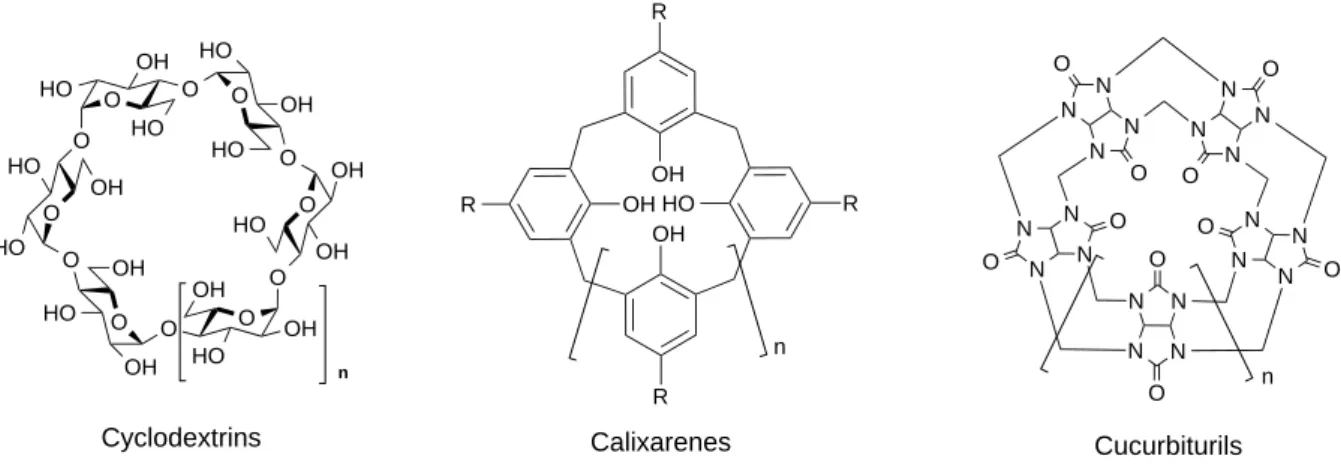
![Figure I-‐4. Calix[6]arene-‐based metal complexes](https://thumb-eu.123doks.com/thumbv2/123doknet/14600196.731017/22.892.80.825.704.889/figure-calix-arene-based-metal-complexes.webp)

